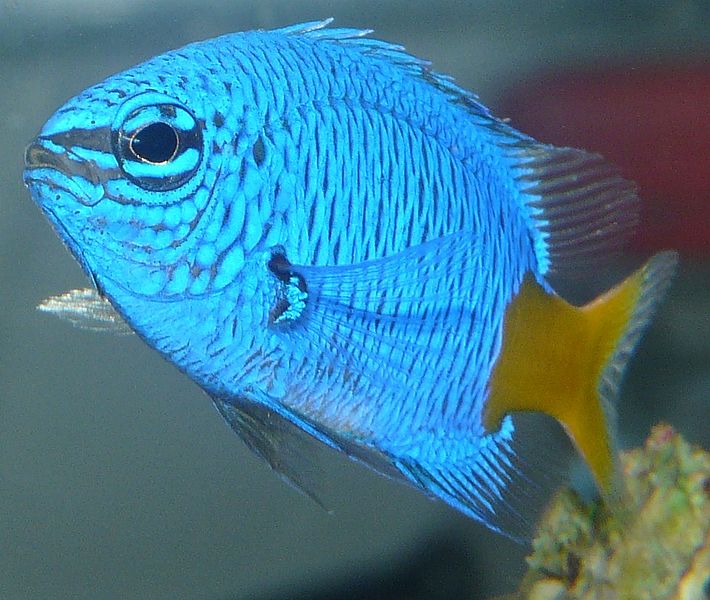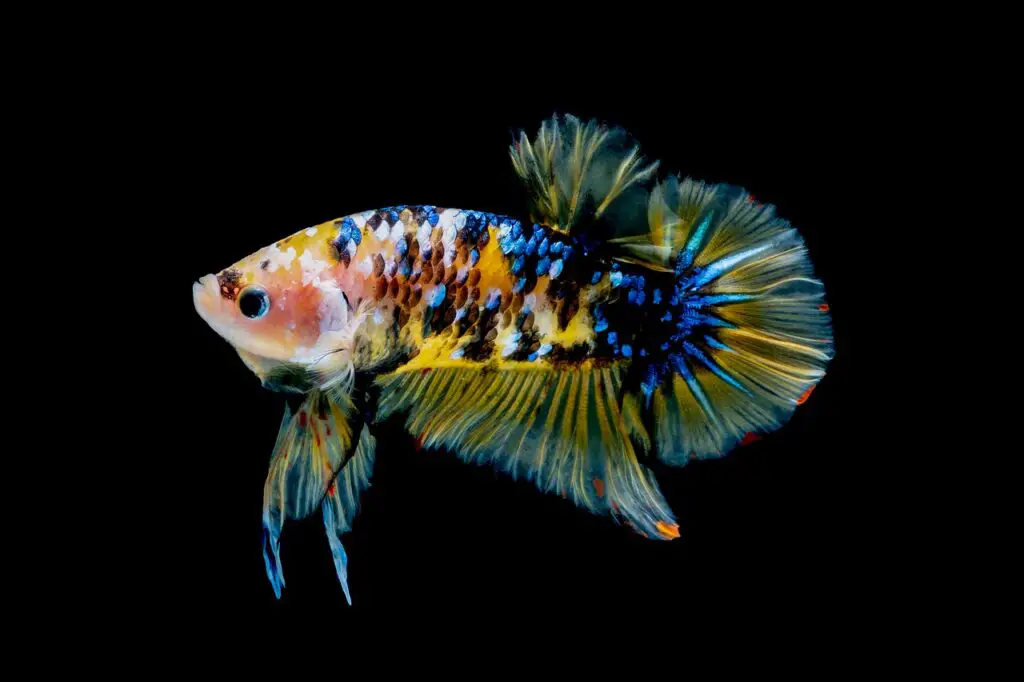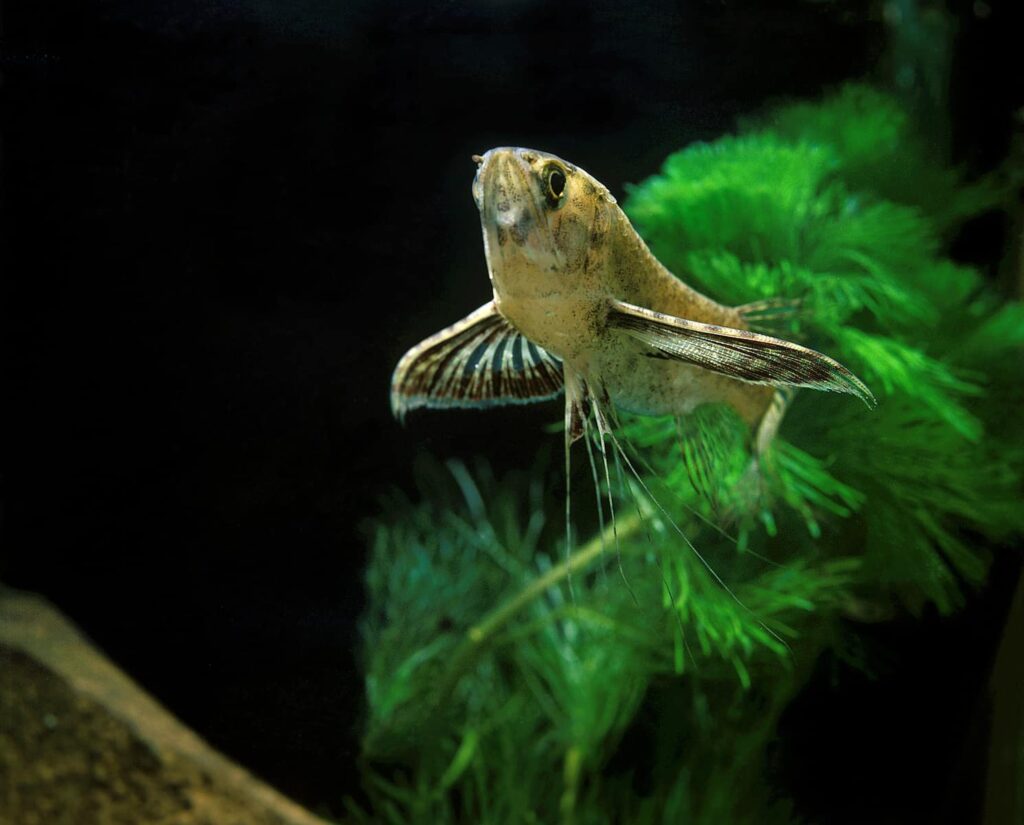Yellowtail blue damsels are beautiful, but like many damselfish, they can get a bit bossy! They are generally less aggressive than some of their cousins, but they may still try to claim areas of the tank as their own. This is natural behavior, but you can manage it. Give them plenty of space and hiding places (like little caves or rock formations). Introducing them to an aquarium with larger, peaceful fish is usually best so they’re less likely to be top dogs.

Yellowtail Blue Damselfish are fairly small, generally reaching a maximum length of 2.8-3 inches (7.1-7.6 cm). Their hardiness and attractive appearance have continued popularity in saltwater aquariums worldwide. Known to be quite resilient and adaptable, these fish are suitable for a wide array of aquarium setups and are an excellent choice for many marine hobbyists.
In their natural habitat, Yellowtail Blue Damselfish can be found near coral reefs, where they feed on tiny plankton and algae. Their bright colors make them visually appealing and effectively camouflage in their vibrant surroundings. These stunning fish not only add a splash of color to any aquarium but can also bring life to their environment with their spirited and active behavior.
Species Overview

Scientific Classification
The Yellowtail Blue Damsel, also known as Chrysiptera Parasema, is a small, vibrantly colored saltwater fish that belongs to the Pomacentridae family. This family includes over 250 species of damselfish, many known for their bright coloration, hardiness, and low maintenance requirements.
Scientific Name: Chrysiptera Parasema
Family: Pomacentridae
Max Size: 2.5 – 3 inches (6.4 – 7.6 cm)
Color: Blue body, Yellow tail
Natural Habitat
The Yellowtail Blue Damsel is native to the warm, tropical waters of the Indo-Pacific region. It can be found in areas ranging from the eastern Indian Ocean through the Philippines, Indonesia, and New Guinea to Australia’s Great Barrier Reef. Due to its eye-catching appearance and its adaptability to various marine environments, the Yellowtail Blue Damsel has been a popular choice for aquarium enthusiasts for several decades.
These curious and active fish can often be found in shallow coral reefs. Their preference for such habitats is particularly important for those looking to replicate a natural environment in their aquarium. Providing them adequate shelter and space to explore is advisable, as they are pretty active and may become territorial.
Their diet consists of various small invertebrates and algae, which can be supplemented with high-quality pellet foods specifically designed for marine species. This ensures they receive the necessary nutrients to maintain their vibrant color and overall health.
Physical Characteristics
Color and Appearance
The Yellowtail Blue Damsel, also known as Chrysiptera parasema, is a striking and vibrant fish that stands out due to its unique color combination. Its deep blue body color beautifully contrasts with its bright yellow caudal fin, making it easily recognizable among other species. In some parts of the world, these fish may also display yellow pelvic and pectoral fins, adding to their eye-catching appearance.
The Chrysiptera genus includes other colorful species, such as the Blue Devil Damsel and the Azure Damsel. Both species, like the Yellowtail Damsel, have blue bodies, but while the Blue Devil Damsel features a neon blue appearance, the Azure Damsel has a more muted, light blue color.
Size and Growth
As a relatively small fish, the Yellowtail Damsel reaches an adult size of around 2.5-3.0 inches (6.4-7.6 cm) in length. In comparison, the Blue Devil Damsel and Azure Damsel have a similar size range, making all three species suitable for smaller saltwater aquariums.
Regarding growth rate, Yellowtail Blue Damsel, as well as other species in the Chrysiptera genus, tend to have a moderate rate. Aquarists must monitor and provide optimal water conditions to ensure their fish’s healthy growth and development.
Overall, the Yellowtail Blue Damsel, Blue Devil Damsel, and Azure Damsel share similar physical characteristics, such as their vibrant blue coloration and small size. These attributes make them popular choices for saltwater aquarium enthusiasts.
Behavioral Traits
Social Behavior
Yellowtail Blue Damsels (Chrysiptera parasema) are small, vibrant fish commonly found in the saltwater aquarium hobby. Despite their stunning appearance, these damselfish exhibit some social behaviors that potential owners should be aware of. In general terms, Yellowtail Blue Damsels are considered relatively less aggressive than their other damselfish relatives, such as the Blue Devil and Domino Damsel. However, they tend to become territorial, which is an important factor to keep in mind when planning your aquarium setup.
Regarding compatibility, Yellowtail Blue Damsels can coexist with other similar-sized or larger fish. However, they might display aggression towards smaller, more passive species. Introducing these damselfish to the tank before other potential tank mates are recommended to ease their territorial behavior and enhance the chances of peaceful coexistence.
Territorial Nature
Yellowtail Blue Damsels’ territorial behavior can be managed by providing an adequate living environment. An adequately designed aquarium that offers plenty of hiding spots, such as caves and crevices, can help limit their territorial tendencies. It is also essential to maintain a spacious tank, as overcrowding can exacerbate their aggressiveness.
To further minimize territorial issues, it’s advisable to keep only one Yellowtail Blue Damsel per tank or to maintain a larger group of them in bigger aquariums. In either case, these fish need ample swimming space and suitable retreat options to reduce stress and territorial disputes.
Remember to consider the unique behavioral traits of Yellowtail Blue Damsels when selecting tank mates and planning your aquarium setup. Although they can be a bit territorial, finding the right balance of compatible species and providing adequate space and hiding spots can result in a harmonious and visually striking underwater world.
Aquarium Care
Tank Requirements
When setting up an aquarium for a Yellowtail Blue Damselfish, it’s important to consider the tank size and the type of tank you plan to create. These fish thrive in both fish-only and reef tanks. The minimum recommended tank size for a Yellowtail Blue Damselfish is 30 gallons. They are known to be quite active swimmers, so providing adequate space is crucial for their well-being.
Water Conditions
Yellowtail Blue Damselfish are saltwater fish that require specific water conditions to thrive. The ideal water temperature should be between 75 and 80°F (24-27°C). The pH level should be 8.1-8.4, and water hardness should be between 8 and 12 dKH. Monitoring and maintaining these parameters consistently is essential, as drastic fluctuations can stress the fish, leading to health issues.
Feeding and Diet
Yellowtail Blue Damselfish have an omnivorous diet, which requires a combination of plant—and animal-based foods. Offer a mix of high-quality flakes, pellets, frozen or live brine shrimp, and vegetables like spinach or lettuce. This care guide has more information about their diet.
To ensure proper nutrition and prevent overfeeding, follow these guidelines when feeding your Yellowtail Blue Damselfish:
- Feed small amounts two to three times a day.
- Remove any uneaten food after 2-3 minutes to maintain water quality.
Remember that a balanced and varied diet is essential for the health and happiness of your Yellowtail Blue Damselfish. By providing the proper tank requirements, maintaining ideal water conditions, and offering a suitable diet, you can help ensure a thriving environment for your fish.
Compatibility with Other Fish
Suitable Tank Mates
Yellowtail Blue Damselfish are known to be moderately aggressive in nature, which may cause concern when selecting compatible tank mates. Nevertheless, several fish species can coexist in harmony with the Yellowtail Blue Damselfish:
- Reef Safe: They are considered reef safe and can live alongside various coral frags and invertebrates.
- Peaceful Tankmates: While not considered fully peaceful, they can dwell with similar semi-aggressive species such as wrasses or dwarf angelfish. Dwarf angelfish, for instance, are compatible with Starck, Talbot, and Yellowtail Damselfish.
- Clownfish: They can typically share a tank with clownfish, although caution is advised when introducing Yellowtail Blue Damselfish. Evaluate the temperament of your existing clownfish to minimize compatibility issues.
- Angelfish, Wrasses, and Grouper: As mentioned earlier, dwarf angelfish and some wrasses can be good tank mates. However, avoid larger and more aggressive angelfish species and groupers, as they might intimidate the damselfish or display territorial behaviors.
Cautions
Here are some important points to consider when introducing a Yellowtail Blue Damselfish to your tank:
- Keeping two Yellowtail Blue Damsels together is not advised, as they could fight for dominance. In such cases, having only one or a group of four or more is better.
- Always introduce the Yellowtail Blue Damselfish to the tank before more aggressive species, to minimize the chances of bullying or territorial conflicts.
- Ensure the availability of hiding spaces and swimming areas for the Yellowtail Blue Damselfish and its tank mates, as this helps reduce aggression and maintain peace in the tank.
When selecting compatible tank mates for a Yellowtail Blue Damsel, consider the species’ temperament, size, and care requirements. Providing a suitable environment with ample space and hiding spots will promote a harmonious marine aquarium experience for all its inhabitants.
Breeding and Reproduction
Breeding in Captivity
Breeding the Yellowtail Blue Damselfish (Chrysiptera parasema) in captivity can be challenging yet rewarding. One crucial step is to establish a breeding pair. This can be done by acquiring a group of juveniles and allowing them to grow together. Males and females don’t have apparent external differences, so observing their behavior for signs of pairing is essential.
When a pair forms, providing them with a separate breeding tank is advisable, ensuring the environment is stable and optimal. Ideal conditions include water temperature between 75 and 80°F and a pH between 8.1 and 8.41. Additionally, suitable hiding spots and flat surfaces where the female can lay her eggs are essential.
Once the mating begins, the male displays territorial behavior, protecting the chosen nesting site. Females can then lay up to 1000 eggs1 on flat surfaces, and the male fertilizes them. The eggs are adhesive, so they stick to the chosen location. Both parents guard the eggs, and the male aggressively chases away potential predators.
Rearing Offspring
The larval stage is perhaps the most challenging aspect of breeding Yellowtail Blue Damselfish. The eggs hatch within 6 to 7 days, and the larvae are barely visible, measuring merely 2-3 mm1. At this stage, preparing the right food for baby damselfish, known as fry is crucial.
A proven diet for damselfish at this stage consists of:
- Rotifers (first 10-12 days)
- Newly hatched brine shrimp (from Day 12 onwards)
Careful water management is essential during the larval stage, as fluctuating conditions can lead to significant fry loss. Water changes need to be consistent, ensuring ammonia and nitrite levels stay close to zero1. Gradually, the offspring will start to develop adult features, and after around 30 days1, they can be introduced to a regular diet.
Health and Diseases
Common Illnesses
Like all saltwater fish, yellowtail blue damselfish can be affected by various illnesses. Among the most common areich and marine velvet. Ich, or white spot disease, is caused by a parasite and manifests as white spots on the fish’s body. In contrast, marine velvet is a highly contagious infection characterized by a golden or brown dust-like appearance on the fish’s body.
These fish are also susceptible to viral and bacterial infections, which can be detrimental to the damselfish and other tank inhabitants. Parasites, such as flukes and copepods, can also impact the health of the damselfish and its surrounding environment, particularly coral reefs and invertebrates.
Preventive Care
Proactive measures can greatly reduce the likelihood of diseases affecting the Yellowtail Blue Damselfish. Here are some steps to follow for preventive care:
- Maintaining a clean, stress-free environment by performing regular water changes and monitoring water quality parameters.
- Quarantine new tank mates before adding them into the main aquarium to prevent the introduction of pathogens.
- To bolster their immune systems, keep the damselfish on a varied and nutritious diet, including high-quality pellets and frozen foods.
- Adding appropriate tank mates and ensuring that fish are compatible will help prevent aggression-induced stress, which can lead to illness.
- Monitor your fish regularly for signs of distress or abnormal behavior. Early intervention is crucial to treating health issues.
Following these guidelines can greatly improve the health and well-being of your Yellowtail Blue Damselfish and ultimately maintain the overall harmony of your aquarium and its inhabitants, including coral reefs and invertebrates, allowing them to thrive in their environment.
Conservation Status and Future
Sustainable Aquaculture
To mitigate these environmental threats and preserve both the yellow tail blue damsel and their reef ecosystems, sustainable aquaculture practices have been implemented. Captive breeding and mariculture are gaining recognition because they can help reduce the pressure on wild populations4. Additionally, they can contribute positively to Reef Conservation efforts by supporting the sustainable supply of ornamental fish for the global aquarium trade, ensuring healthier coral ecosystems5.
Careful monitoring and regulation of the aquarium trade is vital in encouraging sustainable practices. Certifications, such as the Marine Aquarium Council (MAC), have emerged to enforce responsible harvesting, handling, and husbandry practices for coral and marine ornamental species6.
In conclusion, the yellow tail blue damsel’s conservation status is closely tied to the health of the coral reefs they inhabit. Sustainable aquaculture practices provide conservation potential by easing pressures on wild populations and coral ecosystems. Continuous initiatives to monitor and regulate the aquarium trade ensure long-term protection for this vibrant species and its essential habitat.
FAQ
Q: I have a small tank. Can I still keep a yellowtail blue damsel?
A: While yellowtail blue damsels are relatively small, they are still active swimmers and need space to feel comfortable. A 30-gallon tank is the absolute minimum to keep a single damselfish happy. If you have an aquarium smaller than that, you might want to consider species that stay smaller and don’t require as much swimming room.
Q: Are yellowtail blue damselfish easy to care for?
A: Compared to some other saltwater fish, yellowtail damsels are considered relatively easy to care for. They are hardy and adaptable, making them a good choice for beginners to saltwater setups. However, they still need quality food, clean water, and a tank that meets their space requirements.
Q: Do yellowtail blue damsels need live rock?
A: Live rock is not strictly necessary for yellowtail damsels, but it is highly recommended. Live rock provides hiding places, which helps these fish feel secure and reduces territorial aggression. It also helps filter the water and create a more natural environment.
Q: Can I keep more than one yellowtail blue damsel in my tank?
A: It’s best to either keep just one yellowtail blue damsel or a larger group (5 or more) in a sizable tank. Keeping just two can lead to aggression and territorial disputes. In a larger group, aggression is diffused, making it less likely for any one fish to be targeted.
Q: I’m new to saltwater aquariums. Are yellowtail blue damselfish a good fish for a beginner?
A: Yellowtail blue damsels can be a good choice for beginners. They are hardier than other saltwater species, and their care requirements are relatively straightforward. However, it’s important to be prepared to monitor water quality, provide a balanced diet, and be mindful of potential aggression issues when introducing them to other fish.
Footnotes
- (https://sealifeplanet.com/yellowtail-damselfish/) ↩ ↩2 ↩3 ↩4 ↩5 ↩6
- Coral reef degradation jeopardizes the natural habitat of the yellow tail blue damsel. ↩
- The aquarium trade and collection pressures directly impact the health and stability of coral habitats. ↩
- Captive breeding and mariculture can help reduce pressure on wild populations. ↩
- Sustainable aquaculture contributes positively to reef conservation efforts. ↩
- Marine Aquarium Council (MAC) enforces responsible harvesting, handling, and husbandry practices for coral and marine ornamental species. ↩



